Caryn
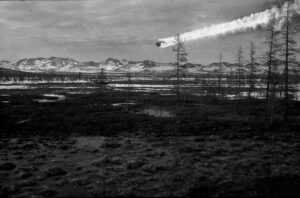 Most of us don’t really think much about the possibility of a meteor hitting the Earth, and the reality is that it’s pretty rare…at least one of much size. Most of them burn up as they enter our atmosphere, and most often the ones that do hit are so small that they do little damage. The Tunguska event a definite exception to that rule. Coming in from the east-southeast, and at and incredible speed of about 60,000 miles per hour, but amazingly still not actually impacting the Earth, it was still classified as an impact event, even though no impact crater has been found. Instead, the object is thought to have disintegrated at an altitude of 3 to 6 miles above the surface, rather than actually impacting the Earth. The meteor did not simply fall apart or burn up, but rather it blew up in what was estimated as a 12-megaton explosion, near the Podkamennaya Tunguska River in Yeniseysk Governorate, which is now Krasnoyarsk Krai, Russia, on the morning of June 30, 1908.
Most of us don’t really think much about the possibility of a meteor hitting the Earth, and the reality is that it’s pretty rare…at least one of much size. Most of them burn up as they enter our atmosphere, and most often the ones that do hit are so small that they do little damage. The Tunguska event a definite exception to that rule. Coming in from the east-southeast, and at and incredible speed of about 60,000 miles per hour, but amazingly still not actually impacting the Earth, it was still classified as an impact event, even though no impact crater has been found. Instead, the object is thought to have disintegrated at an altitude of 3 to 6 miles above the surface, rather than actually impacting the Earth. The meteor did not simply fall apart or burn up, but rather it blew up in what was estimated as a 12-megaton explosion, near the Podkamennaya Tunguska River in Yeniseysk Governorate, which is now Krasnoyarsk Krai, Russia, on the morning of June 30, 1908.
The explosion was over the sparsely populated Eastern Siberian Taiga, which likely saved many lives, but  flattened an estimated 80 million trees over an area of 830 square miles of forest. The people who did witness the explosion, from a great distance, of course, reported that at least three people may have died in the event. The explosion is generally attributed to a meteor air burst, which is the atmospheric explosion of a stony asteroid approximately 160–200 feet in size. The Tunguska event remains the largest impact event on Earth in recorded history, though it is assumed that much larger impacts have occurred in times before history was recorded. An 12-megaton explosion could destroy a large city. Of course, events like this and even smaller ones have caused scientists to attempt to figure out ways to avoid these “direct hits” in the future…a rather large job, since moving the Earth out of the way of asteroids is really not an option.
flattened an estimated 80 million trees over an area of 830 square miles of forest. The people who did witness the explosion, from a great distance, of course, reported that at least three people may have died in the event. The explosion is generally attributed to a meteor air burst, which is the atmospheric explosion of a stony asteroid approximately 160–200 feet in size. The Tunguska event remains the largest impact event on Earth in recorded history, though it is assumed that much larger impacts have occurred in times before history was recorded. An 12-megaton explosion could destroy a large city. Of course, events like this and even smaller ones have caused scientists to attempt to figure out ways to avoid these “direct hits” in the future…a rather large job, since moving the Earth out of the way of asteroids is really not an option.
The Tunguska Event was a mystery for some time, after locals reported hearing a shattering explosion. Upon  investigation, it was found that trees were charred and leveled, and also that seismic waves were felt traveling through Europe. There are still some questions concerning the event, but it is widely believed to have been a comet colliding with Earth’s atmosphere. It is estimated that the explosion occurred 15,000-30,000 feet above the surface of the Earth. That explains the fact that no impact crater was found, still one would expect an explosion of that magnitude to trigger a massive fire. It did not, causing scientists to speculate that the subsequent blast wave doused the flames. Still, the massive amount of energy expelled by the blast is estimated to have been stronger than the bomb dropped on Hiroshima.
investigation, it was found that trees were charred and leveled, and also that seismic waves were felt traveling through Europe. There are still some questions concerning the event, but it is widely believed to have been a comet colliding with Earth’s atmosphere. It is estimated that the explosion occurred 15,000-30,000 feet above the surface of the Earth. That explains the fact that no impact crater was found, still one would expect an explosion of that magnitude to trigger a massive fire. It did not, causing scientists to speculate that the subsequent blast wave doused the flames. Still, the massive amount of energy expelled by the blast is estimated to have been stronger than the bomb dropped on Hiroshima.
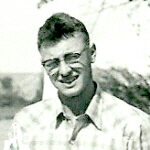
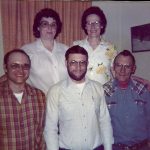 My husband’s uncle, Butch Hein is the youngest of his grandmother, Vina Hein’s five children. Grandma had two children, Marion Kanta and Walt Schulenberg (my husband’s dad) from her first marriage to Andrew Schulenberg; and three children, Esther Hein, Eddie Hein, and Bernard “Butch” Hein, from her second marriage to Walt Hein. Durning her second marriage, the family lived on the ranch that had been owned by Walt’s dad, Christian Hein. Because of that, ranching was practically a part of Butch’s DNA, It was as much a part of his as the air he breathed. While the older children really didn’t want to be ranchers, Butch really did, and since parents usually try to pass their lives’ work down to their kids, Walt had hoped that one of his kids would want to be a rancher. Butch fulfilled the desire his dad had. They worked the ranch together, and when Walt was ready, Butch took over in his dad’s retirement years.
My husband’s uncle, Butch Hein is the youngest of his grandmother, Vina Hein’s five children. Grandma had two children, Marion Kanta and Walt Schulenberg (my husband’s dad) from her first marriage to Andrew Schulenberg; and three children, Esther Hein, Eddie Hein, and Bernard “Butch” Hein, from her second marriage to Walt Hein. Durning her second marriage, the family lived on the ranch that had been owned by Walt’s dad, Christian Hein. Because of that, ranching was practically a part of Butch’s DNA, It was as much a part of his as the air he breathed. While the older children really didn’t want to be ranchers, Butch really did, and since parents usually try to pass their lives’ work down to their kids, Walt had hoped that one of his kids would want to be a rancher. Butch fulfilled the desire his dad had. They worked the ranch together, and when Walt was ready, Butch took over in his dad’s retirement years. 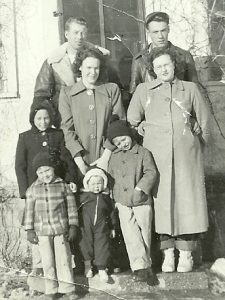
Butch was quite a bit younger than my father-in-law, Walt Schulenberg, so his nieces and nephews were not that much older than their uncle. Butch was just four years old when he first became an uncle, and by the time he was ten years old he had five nieces and one nephew, and more would follow in quick succession. By the time his siblings were done having children, Butch would have nineteen nieces and nephews. He would also have a son named Scott, and a daughter named Crista, who died in infancy. In reality, Butch didn’t really remember life without nieces and nephews. I’m sure that as a young uncle, or more correctly, a kid who was an uncle, having nieces and nephews gave Butch a lot of “friends” to play with, in addition to his older sister and brother.
There is lots to do on a ranch. In addition to the cattle, there are horses to ride and usually other animals to help out with. Life on a ranch usually includes other types of animals that can be used to food, as well as a garden, which I know Grandma had. What kid do you know that wouldn’t go and have a little “garden raid” when they wanted a snack. Beans and carrots make great fresh snacks, and I’m sure Butch and his 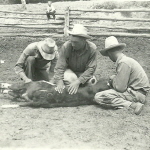
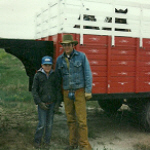 siblings took full advantage of that fact, although probably not to a large extent, because if you eat all the vegetables in the garden, your Mom and Dad would be sure to notice. Besides that, helping on a ranch keeps a kid pretty busy. Most of their “snacks” were in the form of big meals at mealtime. As hard as the work was, Butch thrived on it, and couldn’t wait to work on the ranch with his dad as an adult. Him taking over the ranch was inevitable, and Butch was very happy about that. Today is Butch’s birthday. Happy birthday Butch!! Have a great day!! We love you!!
siblings took full advantage of that fact, although probably not to a large extent, because if you eat all the vegetables in the garden, your Mom and Dad would be sure to notice. Besides that, helping on a ranch keeps a kid pretty busy. Most of their “snacks” were in the form of big meals at mealtime. As hard as the work was, Butch thrived on it, and couldn’t wait to work on the ranch with his dad as an adult. Him taking over the ranch was inevitable, and Butch was very happy about that. Today is Butch’s birthday. Happy birthday Butch!! Have a great day!! We love you!!

 My grandnephew, Chris Spicer just graduated from high school and then immediately moved with his mom, Andrea Beach, from Rawlins, Wyoming to Casper, Wyoming. Andrea has always wanted to live in Casper, and Chris wants that too, especially since he will be going to college at Casper College in the fall to study Graphic Design. It has been a very eventful year for Chris. He had been thinking about becoming a phlebotomist, but with everything going on in the world, he decided that he would switch gears, and go with Graphic Design.
My grandnephew, Chris Spicer just graduated from high school and then immediately moved with his mom, Andrea Beach, from Rawlins, Wyoming to Casper, Wyoming. Andrea has always wanted to live in Casper, and Chris wants that too, especially since he will be going to college at Casper College in the fall to study Graphic Design. It has been a very eventful year for Chris. He had been thinking about becoming a phlebotomist, but with everything going on in the world, he decided that he would switch gears, and go with Graphic Design.
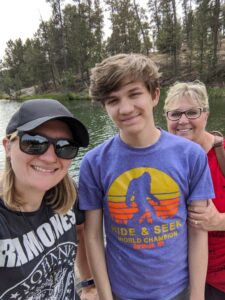
Chris is really happy to be living in Casper. His grandparents, Caryl and Mike Reed, live here too. Chris and his mom are living in the apartment on the Reed ranch for now, while they look for jobs and an apartment. First, however, comes their annual trip to the Black Hills, which is normally Chris, his mom, and his grandma, but this year is going to include his grandpa too. They left yesterday, and one of the highlights o this trip is the planned tour through one or more of the caves in the Black Hills. They haven’t done that before, so they are very excited. I have done them several times, so I can say that they will have a great time. They might even try Zip Lining!! For Chris, this is a prelude to the rest of his life. It’s a vacation they take every year, but this time will be different to a degree. It will be more like a graduation trip too, but it will be different in another way, because Chris and his mom will not be returning to Rawlins, and he will not be going back to high school in the fall. All of that is his past life, and he is starting a new life now.
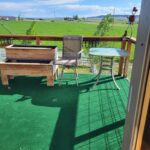
 Chris is a vibrant, happy person, with a great smile. He loves playing video games and at least in the past, has loved longboarding, although where his is living right now, he might not be able to use it. The apartment they are currently living in has beautiful views, but not much concrete. Nevertheless, once school starts, he may not have much time for games and longboarding. His time will most likely be taken up by books and computer work. I think it is going to be an exciting life for Chris, and I wish him all the best. Today is Chris’ 18th birthday. Happy birthday Chris!! Have a great day!! We love you!!
Chris is a vibrant, happy person, with a great smile. He loves playing video games and at least in the past, has loved longboarding, although where his is living right now, he might not be able to use it. The apartment they are currently living in has beautiful views, but not much concrete. Nevertheless, once school starts, he may not have much time for games and longboarding. His time will most likely be taken up by books and computer work. I think it is going to be an exciting life for Chris, and I wish him all the best. Today is Chris’ 18th birthday. Happy birthday Chris!! Have a great day!! We love you!!
 For most women, especially during the Revolutionary War era, life’s losses brought a long time of mourning, the wearing of black dresses, and times of reflection, before they eventually consider remarrying. For Anne Hennis Trotter Bailey, whose lifestyle earned her the name “Mad Anne” for her acts of bravery and heroism that were considered to be somewhat eccentric for a woman of her time, loss brought about quite the opposite reaction. Anne Hennis was born in Liverpool England in 1742. She was formally educated and learned to read and write. Her first experience with loss came before she turned 18. It is not known how they died, but both of Anne’s parents were gone before she turned 18, and she became an orphan. Life for Ann, who was poor and had a hard time earning enough money to survive, immediately became very hard. Anne had family near Staunton in the Shenandoah Valley, and when she was 19, she sailed to America to live with them. There, in 1765, she met and married Richard Trotter, a seasoned frontiersman and experienced soldier. The couple had one son named William.
For most women, especially during the Revolutionary War era, life’s losses brought a long time of mourning, the wearing of black dresses, and times of reflection, before they eventually consider remarrying. For Anne Hennis Trotter Bailey, whose lifestyle earned her the name “Mad Anne” for her acts of bravery and heroism that were considered to be somewhat eccentric for a woman of her time, loss brought about quite the opposite reaction. Anne Hennis was born in Liverpool England in 1742. She was formally educated and learned to read and write. Her first experience with loss came before she turned 18. It is not known how they died, but both of Anne’s parents were gone before she turned 18, and she became an orphan. Life for Ann, who was poor and had a hard time earning enough money to survive, immediately became very hard. Anne had family near Staunton in the Shenandoah Valley, and when she was 19, she sailed to America to live with them. There, in 1765, she met and married Richard Trotter, a seasoned frontiersman and experienced soldier. The couple had one son named William.
During the westward movement, when more and more people were heading west in search of land and adventure, fights began to break out between settlers and the Indians who had lived there for many years. The Governor of Virginia organized border militia to protect the settlers there. Richard Trotter joined this militia. On October 19, 1774, Shawnee Chief Cornstalk attacked the Virginia militia, hoping to halt their advance into the Ohio Country. This became known as the Battle of Point Pleasant. The battle raged on until Cornstalk finally retreated. The Virginians, along with a second force led by Lord Dunmore, the Royal Governor of Virginia, then marched into the Ohio Country. Cornstalk had no choice but to agree to a treaty, ending the war. Many men on both sides lost their lives in the battle, including Richard Trotter.
For Anne this could have meant years of sadness as a widow, but Anne would have none of that. Anne, upon learning of her husband’s death, and determined to seek revenge, left her young son in the care of neighbors, dressed in the clothing of a frontiersman, and set out to avenge her loss. A woman alone going out to kill the Indians seemed like an insane move to make, and most people probably thought she would be dead in a matter of days…but they didn’t know Anne. She became known as “Mad Anne” from that time forward….to whites and Indians alike. In the beginning, Anne rode from one recruiting station to another, asking them to volunteer their services to the militia in order to keep the women and children of the border safe, to fight for freedom from the Indians, and later the British.
People from Staunton, Virginia, to what is now Charleston, West Virginia, and Gallipolis, Ohio, knew Anne, mostly due to the unusual sight she presented. She usually wore buckskin leggings, petticoats, heavy brogan shoes, a man’s coat and hat, a hunting knife in a belt around her waist, and a rifle slung over her shoulder…everything she needed to be in the pioneer spirit in the late 1700s. Although Mad Anne mostly rode up and down the western frontier, she also recruited for the Continental Army, and delivered messages between various Army detachments during the Revolutionary War. It seemed that there was no job she wouldn’t take, including traveling as a courier on horseback between Forts Savannah and Randolph, a distance of almost 160 miles. Her fearless personality made her well known and respected by the settlers along the route. Mad Anne 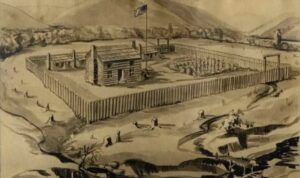 was even respected, or maybe feared is a better word, by the Shawnee Indians. On her rides Bailey often came across a particular group of Shawnee Indians. They often chased her, then on one such encounter, she had had enough. Just when she was about to be caught, she jumped off her horse and hid in a log. Strangely, the Shawnee looked everywhere for her and even stopped to rest on the log, but they could not find her. Finally, they gave up and stole her horse. She waited a while after they left, and then came out of the log. She waited until nightfall, then crept into their camp and retrieved her horse…a bold move, but nothing like the next move she made. Once she was far enough away, she started screaming and shrieking at the top of her lungs. Now waking up to that would be shocking enough, but this woman was acting totally crazy, and the Shawnee thought she was possessed and therefore could not be injured by a bullet or arrow. After that display, the Shawnee saw her often, but the kept far away from her, because they were totally afraid of her. With that assurance backing her, Mad Anne knew that she was relatively safe living in the woods.
was even respected, or maybe feared is a better word, by the Shawnee Indians. On her rides Bailey often came across a particular group of Shawnee Indians. They often chased her, then on one such encounter, she had had enough. Just when she was about to be caught, she jumped off her horse and hid in a log. Strangely, the Shawnee looked everywhere for her and even stopped to rest on the log, but they could not find her. Finally, they gave up and stole her horse. She waited a while after they left, and then came out of the log. She waited until nightfall, then crept into their camp and retrieved her horse…a bold move, but nothing like the next move she made. Once she was far enough away, she started screaming and shrieking at the top of her lungs. Now waking up to that would be shocking enough, but this woman was acting totally crazy, and the Shawnee thought she was possessed and therefore could not be injured by a bullet or arrow. After that display, the Shawnee saw her often, but the kept far away from her, because they were totally afraid of her. With that assurance backing her, Mad Anne knew that she was relatively safe living in the woods.
Anne met John Bailey, a member of a legendary group of frontier scouts called the Rangers, after several years living on her own. The Rangers were defending the Roanoke and Catawba settlements from Indian attacks. He was rather smitten with Mad Anne’s rough ways, and they were married November 3, 1785. In 1787, along the Kanawha River at the mouth of the Elk River, a blockhouse was built. The block house would later become Fort Lee in honor of Virginia’s Governor Henry Lee. Fort Lee was where John Bailey was assigned to duty, taking with him his now famous, gun-toting, hard-riding bride.
In 1788, John Bailey was transferred to Fort Clendenin, which was a more active area of conflict between the settlers and Native Americans. Anne Bailey began working for the settlers as well, riding on horseback to warn them of impending attacks. In 1791, she singlehandedly saved Fort Lee from certain destruction by hostile Indians with a three-day, 200–mile round trip to replenish their supply of gunpowder. She rode for hours, finally reaching Fort Savannah at Lewisburg, where the gunpowder was quickly packed aboard her horse and one additional mount, before she reversed her direction and galloped full speed back to Fort Lee.
After she returned, the siege was ended, the attackers were defeated. For her bravery Anne was given the horse that had carried her away and brought her safely back. The animal was said to have been a beautiful black, sporting white feet and a blazed face. She dubbed him Liverpool, in honor of her birthplace. Anne Bailey was forty-nine years old when she made this famous ride. Anne became a legend among the other settlers, and she was always welcome in their homes. John Bailey died in 1802, and Anne decided that she no longer wanted to live in a house, so she lived in the wilderness for over 20 years. She visited friends in town occasionally, but usually slept outside. Her favorite place was a cave near Thirteen Mile Creek.
A widow for the second time, and in her late fifties, Anne later went to live with her son, but her love for riding and of the wilderness had not ceased. For many years afterwards she could be seen riding from Point Pleasant to Lewisburg and Staunton, carrying mail and as an express messenger. Bailey continued working as a messenger, 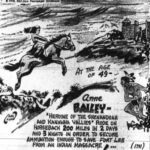 bringing supplies for the settlers throughout the area. She finally retired in 1817 after making one last trip to Charleston at age 75. In 1818 Anne moved with her son and his family to his new farm in Gallia County, Ohio. Instead of asking her to stay with his family, her son, who had apparently never felt any ill-will toward his mother who was often not around, built her a cabin nearby so she would still feel independent. Bailey continued working as a messenger, bringing supplies for the settlers throughout the area. Anne Hennis Trotter Bailey died at Gallipolis, Ohio, November 22, 1825, at the age of 83. She was buried in the Trotter Graveyard near her son’s home, and her remains rested there for seventy-six years. On October 10, 1901, her remains were re-interred in Monument Park in Point Pleasant, under the auspices of the Colonel Charles Lewis, Jr. Chapter of the D. A. R.
bringing supplies for the settlers throughout the area. She finally retired in 1817 after making one last trip to Charleston at age 75. In 1818 Anne moved with her son and his family to his new farm in Gallia County, Ohio. Instead of asking her to stay with his family, her son, who had apparently never felt any ill-will toward his mother who was often not around, built her a cabin nearby so she would still feel independent. Bailey continued working as a messenger, bringing supplies for the settlers throughout the area. Anne Hennis Trotter Bailey died at Gallipolis, Ohio, November 22, 1825, at the age of 83. She was buried in the Trotter Graveyard near her son’s home, and her remains rested there for seventy-six years. On October 10, 1901, her remains were re-interred in Monument Park in Point Pleasant, under the auspices of the Colonel Charles Lewis, Jr. Chapter of the D. A. R.
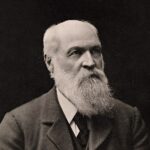
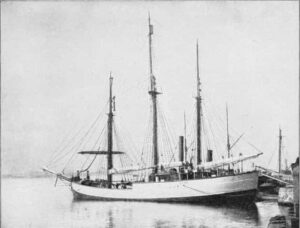 It’s strange to think that someone would build a ship for the sole purpose of freezing it in the Artic ice sheet as a way of “floating” it over the North Pole, but that was exactly the plan when a ship named Fram (meaning Forward) was designed and built by the Scottish-Norwegian shipwright Colin Archer. The ship was built for Fridtjof Nansen’s 1893 Arctic expedition, to actually freeze it in the polar ice. The ship was a special design to be used in expeditions of the Arctic and Antarctic regions by the Norwegian explorers Fridtjof Nansen, Otto Sverdrup, Oscar Wisting, and Roald Amundsen between 1893 and 1912. Nansen’s ambition was to explore the Arctic farther north than anyone else, but he knew that they would be dealing with a problem that many sailing on the polar ocean had encountered before him, a problem that ended their expeditions…the freezing ice could crush a ship and end the expedition. The ship that was going to survive freezing in the Artic ice sheet, would have to be different…in just about every way. Nansen’s idea was to build a ship that could survive the pressure of the ice, not because it was stronger, but because it’s very shape would let the ice push the ship up, so it would actually “float” on top of the ice.
It’s strange to think that someone would build a ship for the sole purpose of freezing it in the Artic ice sheet as a way of “floating” it over the North Pole, but that was exactly the plan when a ship named Fram (meaning Forward) was designed and built by the Scottish-Norwegian shipwright Colin Archer. The ship was built for Fridtjof Nansen’s 1893 Arctic expedition, to actually freeze it in the polar ice. The ship was a special design to be used in expeditions of the Arctic and Antarctic regions by the Norwegian explorers Fridtjof Nansen, Otto Sverdrup, Oscar Wisting, and Roald Amundsen between 1893 and 1912. Nansen’s ambition was to explore the Arctic farther north than anyone else, but he knew that they would be dealing with a problem that many sailing on the polar ocean had encountered before him, a problem that ended their expeditions…the freezing ice could crush a ship and end the expedition. The ship that was going to survive freezing in the Artic ice sheet, would have to be different…in just about every way. Nansen’s idea was to build a ship that could survive the pressure of the ice, not because it was stronger, but because it’s very shape would let the ice push the ship up, so it would actually “float” on top of the ice.
Fram is a three-masted schooner with a total length of 127 feet 11 inches and width of 36 feet 1 inch. The ship was designed to be both unusually wide and unusually shallow in order to better withstand the forces of pressing ice. By design it would be able to push up through the ice to the top of the ice sheet, thereby allowing 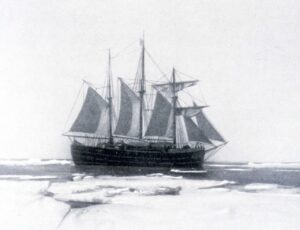 it to float. Fram’s outer layer was made of, which can withstand the ice. It also had almost no keel so it could handle the shallow waters Nansen expected to encounter. The ship was designed with a retractable rudder and propeller, and it was carefully insulated to allow the crew to live on board for up to five years. A windmill was installed to run a generator that would provide electric power for lighting by electric arc lamps. The ship was launched on 26 October 1892. During the initial building process, Fram was fitted with a steam engine, which was fine, until something better came along. Then, before Amundsen’s expedition to the South Pole in 1910, the engine was replaced with a diesel engine, a first for polar exploration vessels.
it to float. Fram’s outer layer was made of, which can withstand the ice. It also had almost no keel so it could handle the shallow waters Nansen expected to encounter. The ship was designed with a retractable rudder and propeller, and it was carefully insulated to allow the crew to live on board for up to five years. A windmill was installed to run a generator that would provide electric power for lighting by electric arc lamps. The ship was launched on 26 October 1892. During the initial building process, Fram was fitted with a steam engine, which was fine, until something better came along. Then, before Amundsen’s expedition to the South Pole in 1910, the engine was replaced with a diesel engine, a first for polar exploration vessels.
Because of wreckage found at Greenland from USS Jeannette, which was lost off Siberia, and driftwood found in the regions of Svalbard and Greenland, Nansen had a theory that an ocean current flowed beneath the Arctic ice sheet from east to west, bringing driftwood from the Siberian region to Svalbard and further west. That was the main reason for building Fram. He wanted to order to explore this theory. His expedition ended up lasting three years, during which time, Nansen realized that Fram would not reach the North Pole directly. The current either wasn’t strong enough, or the polar ice was actually on land at the North Pole. So, he and Hjalmar Johansen set out to reach it on skis. After reaching 86° 14′ north, he had to turn back to spend the winter at Franz Joseph Land. During their expedition, Nansen and Johansen survived on walrus and polar bear meat and blubber. Finally, after they met up with British explorers from the Jackson-Harmsworth Expedition, they arrived back in Norway only days before the Fram also returned there. Their skiing mission was far more successful than the Fram’s mission, as the ship had spent nearly three years trapped in the ice, after only reaching 85° 57′ N. Fram made a scientific expedition to the Canadian Artic Archipelago between 1892 and 1902, and after being fitted with the diesel engine, Amundsen made his South Pole expedition from 1910 to 1912. Fram was 
 the first ship to reach the South Pole, during which Fram reached 78° 41′ S.
the first ship to reach the South Pole, during which Fram reached 78° 41′ S.
Following these expeditions, Fram was left to decay in storage from 1912 until the late 1920s. Then, Lars Christensen, Otto Sverdrup, and Oscar Wisting decide to begin an effort to preserve it by starting the Fram Committee. Finally, the now restored ship was installed in the Fram Museum in 1945, where it now stands.

 My grandson, Caalab Royce, who lives in Bellingham, Washington, is such a great guy. When Caalab was in middle school, he decided that he wanted to learn to play the guitar. His dad, Travis Royce played the guitar, and Travis was, and still is, Caalab’s hero. So, when the class was offered, he jumped at the chance to actually learn to play, and not just to try to imitate what his dad was doing. Let’s face it, learning to play is much better than stumbling around with it. Which is exactly what any strumming I could do would be called. Caalab has a natural talent though, and I love to listen to him and his dad play. I think they are both very good. They have a little band that practices in his parents’ garage/T&Avern, which is a very cool place named after its owners, Travis and Amy Royce. Of course, when the weather is nice, they practice in the Royce back yard and garden. Either way, I love to listen whenever I am visiting.
My grandson, Caalab Royce, who lives in Bellingham, Washington, is such a great guy. When Caalab was in middle school, he decided that he wanted to learn to play the guitar. His dad, Travis Royce played the guitar, and Travis was, and still is, Caalab’s hero. So, when the class was offered, he jumped at the chance to actually learn to play, and not just to try to imitate what his dad was doing. Let’s face it, learning to play is much better than stumbling around with it. Which is exactly what any strumming I could do would be called. Caalab has a natural talent though, and I love to listen to him and his dad play. I think they are both very good. They have a little band that practices in his parents’ garage/T&Avern, which is a very cool place named after its owners, Travis and Amy Royce. Of course, when the weather is nice, they practice in the Royce back yard and garden. Either way, I love to listen whenever I am visiting.
Caalab has many talents, among them comedy. He always could tell a joke, never forgetting the punch line, 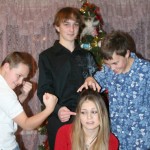
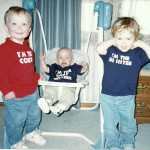 even when he was a little boy, but even more cool is his ability to just be funny. In fact, Caalab hates to be serious. Nevertheless, he has the ability to be serious when it comes to his job as kitchen manager at Red Robin in Bellingham. Let’s face it, kitchen manager at any restaurant is not easy. People in that type of job often don’t want to work. Oh, they want to get paid, but they don’t always want to work for that paycheck. Caalab, as the kitchen manager, has to pick up the slack when one of his kitchen workers doesn’t show up for a shift or when they quit with no notice. It seems to be a common problem in the food industry, no matter what minimum wage is. I think it’s common in many industries. People want a paycheck…but they don’t want a job!!!
even when he was a little boy, but even more cool is his ability to just be funny. In fact, Caalab hates to be serious. Nevertheless, he has the ability to be serious when it comes to his job as kitchen manager at Red Robin in Bellingham. Let’s face it, kitchen manager at any restaurant is not easy. People in that type of job often don’t want to work. Oh, they want to get paid, but they don’t always want to work for that paycheck. Caalab, as the kitchen manager, has to pick up the slack when one of his kitchen workers doesn’t show up for a shift or when they quit with no notice. It seems to be a common problem in the food industry, no matter what minimum wage is. I think it’s common in many industries. People want a paycheck…but they don’t want a job!!!
Caalab has always been a blessing, even if his sister, Shai Royce couldn’t always see the funny side of things, especially when the joke was on her. Nevertheless, these days these two are best friends. Oh, don’t get me wrong, they can argue, but they are still best friends. I always knew they would be, and I told Shai that, but as 
 a young girl, who was always teased by her little brother, she just couldn’t see it. Caalab did love to tease her, but he would have done anything for her too. She was his big sis, and nobody better bother his big sis. For her part, Shai would also do just about anything for her brother too, and she trusts him implicitly, which is quite evident in the fact that for his birthday, she actually bought him a real sword. It is a collector’s sword, but a sword nevertheless, and Caalab thought it was the coolest thing ever. Today is Caalab’s 26th birthday. Happy birthday Caalab!! Have a great day!! We love you!!
a young girl, who was always teased by her little brother, she just couldn’t see it. Caalab did love to tease her, but he would have done anything for her too. She was his big sis, and nobody better bother his big sis. For her part, Shai would also do just about anything for her brother too, and she trusts him implicitly, which is quite evident in the fact that for his birthday, she actually bought him a real sword. It is a collector’s sword, but a sword nevertheless, and Caalab thought it was the coolest thing ever. Today is Caalab’s 26th birthday. Happy birthday Caalab!! Have a great day!! We love you!!

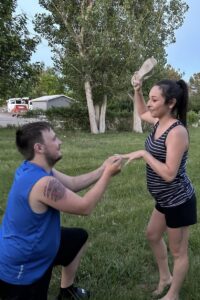 My grandson, Josh Petersen and his fiancée, Athena Salazar met in middle school, and at the time, Athena tells me that she didn’t really like Josh much. That’s not such an odd thing. in those early teen years, everybody feels awkward, and doesn’t really know how to show someone that you like them, and especially for girls, the awkward maneuvering of the teenaged boys makes them someone the girls would rather just avoid. I don’t really know if Josh liked Athena back then, but when they met again, both working at Sanford’s, they knew that things had changed for them. Now before them was a person who was suddenly quite loveable, and they knew that they had found their soulmate for life. Josh and Athena had followed the path of his Grandma and Grandpa Schulenberg, who had known each other all their lives, and for those awkward teen years, she didn’t like him, but then it all changed, and they were together for life. It’s really a sweet story, when you think about it. Today, the story of Josh and Athena is going to the next level.
My grandson, Josh Petersen and his fiancée, Athena Salazar met in middle school, and at the time, Athena tells me that she didn’t really like Josh much. That’s not such an odd thing. in those early teen years, everybody feels awkward, and doesn’t really know how to show someone that you like them, and especially for girls, the awkward maneuvering of the teenaged boys makes them someone the girls would rather just avoid. I don’t really know if Josh liked Athena back then, but when they met again, both working at Sanford’s, they knew that things had changed for them. Now before them was a person who was suddenly quite loveable, and they knew that they had found their soulmate for life. Josh and Athena had followed the path of his Grandma and Grandpa Schulenberg, who had known each other all their lives, and for those awkward teen years, she didn’t like him, but then it all changed, and they were together for life. It’s really a sweet story, when you think about it. Today, the story of Josh and Athena is going to the next level. 
 Today, they will marry the love of their lives. They have been waiting for so long, and they are so excited.
Today, they will marry the love of their lives. They have been waiting for so long, and they are so excited.
We are so happy to have Athena join our family. It is wonderful to see Josh so happy. They couldn’t be more perfect for each other if they tried. They find the same things to be funny, and they love the same things, especially their son, Justin, who was born in 2022 and their little baby boy who will be making his entrance at the end of September. Life is good for these sweet kids, and now it is going to be even sweeter as they become husband and wife. They have so many good things ahead of them and this is just the beginning, the point when two lives who have known each other for so long, 
 and now become one.
and now become one.
Josh and Athena have so much in common, from school days to work, to their likes and dislikes, and their temperaments. They are the kind of people who are always willing to help others, and that endears them to many people. They like to travel and see new places, but they enjoy hanging out at home just as much. Their son, Justin and soon his little brother, Axel are their top priorities, and they love them both so much. They are already such great parents, and so great as a couple, and I know they will be equally as great as husband and wife. Today is the day…their Wedding Day!! Congratulations Athena and Josh!! Congratulations on your marriage!! We are so happy for you both!! We love you!!

 My grandniece, Maya Stevens is such a happy baby girl. She loves playing with her big sister, Elliott Stevens, who very much loves to entertain her little sister. Maya love learning new things. She was just playing with a walker toy and didn’t even realize that she really was walking and walking well. She also stands alone for 10 to 20 seconds before she realizes what she is doing. That’s how it goes with children. If the learning is made to be like play, they learn quickly. It’s the nature of babies and children. Maya loves her parents, Kayla and Garrett Stevens, so much. They are her favorite people. She also loves her grandparents, Alena and Mike Stevens and Lynette and Wes Smiley, very much. She also loves her cousins, especially Brooklyn Killinger, whom she
My grandniece, Maya Stevens is such a happy baby girl. She loves playing with her big sister, Elliott Stevens, who very much loves to entertain her little sister. Maya love learning new things. She was just playing with a walker toy and didn’t even realize that she really was walking and walking well. She also stands alone for 10 to 20 seconds before she realizes what she is doing. That’s how it goes with children. If the learning is made to be like play, they learn quickly. It’s the nature of babies and children. Maya loves her parents, Kayla and Garrett Stevens, so much. They are her favorite people. She also loves her grandparents, Alena and Mike Stevens and Lynette and Wes Smiley, very much. She also loves her cousins, especially Brooklyn Killinger, whom she  will totally hang out with for hours. Of course, she loves Brooklyn’s brother, Jaxxon Killinger too. He makes her laugh.
will totally hang out with for hours. Of course, she loves Brooklyn’s brother, Jaxxon Killinger too. He makes her laugh.
Maya is learning so many new things. She loves kids, but Brooklyn and Elliott are her favorites. She is in that “I don’t like strange adults” stage right now…especially men, and she is very aware of where her mom and Dad are at all times. If they leave the room, Maya knows it. That is rather a common thing among one-year-old children. They just don’t feel comfortable with people they don’t know well. I think its a good thing actually. Maya is crawling around all over the place and getting into stuff. That could be bad, but the house is already kid-proof, so it’s ok. When Maya gets into the pans, it’s time for the “one girl band” to play. She bangs the pans 
 and makes as much noise as she can. She likes banging on pans or anything that makes a loud noise…to the delight of her parents…I’m sure. She loves to play in the water, especially when her daddy makes sure she gets wet.
and makes as much noise as she can. She likes banging on pans or anything that makes a loud noise…to the delight of her parents…I’m sure. She loves to play in the water, especially when her daddy makes sure she gets wet.
Maya doesn’t have any teeth yet, but her mom is sure they will be popping through any day now. Kayla often sends out videos to friends and family so we can see the antics of Elliott and Maya!! We all love to see them very much. The girls are just precious, and they bring joy to anyone who knows them…especially their parents. Maya goes to daycare these days, and the daycare ladies absolutely love her. They are always telling her parents just how sweet she is. Today is Maya’s first birthday. Happy birthday Sweet Maya!! Have a great day!! We love you!!

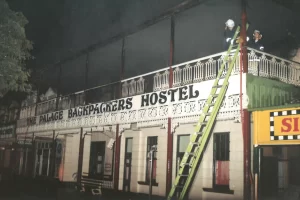 Hiking and Backpacking have been a favorite pastime for many people for many years, and some people go to greater lengths and distances than others. Backpacking in Australia is a trip on the bucket lists of a lot of people. On their hikes, many people have made the Childers Palace Backpackers Hostel one of their stops. Located in the former Palace Hotel in the town of Childers, Queensland, Australia, the building had been converted into a backpacker hostel. That was the stop for 15 backpackers on June 22, 2000. They had been hiking all day and were ready for some downtime. After a relaxed evening, they all went to bed. There were 88 people staying in the building that night, but the building could house 101 people.
Hiking and Backpacking have been a favorite pastime for many people for many years, and some people go to greater lengths and distances than others. Backpacking in Australia is a trip on the bucket lists of a lot of people. On their hikes, many people have made the Childers Palace Backpackers Hostel one of their stops. Located in the former Palace Hotel in the town of Childers, Queensland, Australia, the building had been converted into a backpacker hostel. That was the stop for 15 backpackers on June 22, 2000. They had been hiking all day and were ready for some downtime. After a relaxed evening, they all went to bed. There were 88 people staying in the building that night, but the building could house 101 people.
At about 12:30am on June 23, 2000, a fire started in the downstairs recreation room and quickly spread up the walls and into the stairwell. The first emergency call came from a pay phone across the street, and it was logged at 12:31am. Emergency services first arrived at 12:38am and spent four hours battling the fire before it was fully extinguished. In the aftermath, it was found that 15 backpackers, nine women and six men, had lost their lives. Survivors told of how smoke quickly filled the area and how the building’s power was lost. They struggled in the darkness to find a way out, and in the absence of alarms and emergency lighting, some people attempted to awaken and rescue as many people as they could. Of the 70 backpackers who survived the fire, 10 suffered minor burns and injuries as they tried to escape from the upper level and by jumping onto the roofs of the neighboring buildings. In this fire, those who got out lived, those who died did not get out at all.
Of the 15 who died in the fire, seven were British, three were Australian, two were from the Netherlands, and one each from Ireland, Japan, and South Korea. It took a while to identify the dead, because there was an incomplete hostel register. It recorded check-ins, but unfortunately not departures. To further complicate things, most of the residents’ passports were destroyed or damaged by the fire. DNA samples were also difficult to obtain for those with no relatives in Australia. Most of the backpackers who died were on the first floor of the hostel. Through an inquest, it was found that in one of the upper rooms where 10 victims were found, which was all of the occupants of that room, a bunk bed blocked a fastened exit door, and the windows were barred. They had little chance of escape.
It was found that a fruit packer named Robert Paul Long, had moved into the hostel on March 24, 2000, but had been evicted on June 14, 2000, over a matter of $200 rent in arrears. Long didn’t leave the area, as was seen in ATM records that showed him in the area in the week before the fire. Long, who had expressed a hatred of backpackers, had also earlier threatened to burn down the hostel. Around midnight, prior to the fire, two guests saw Long in the back yard of the hostel. Long had asked them to leave the door open so he could assault his former roommate, an Indian national. They declined, and he told them that he still had a key. Another guest recounted how he had woken up around midnight to find Long downstairs using a PC near a burning rubbish bin. After the guest protested the reckless actions, Long took the bin outside, and the guest went back to bed, but was awakened later to banging sounds, shouting, and thick black smoke.
After the fire, Long tried to mask his movements, but he was later spotted in cane-fields about five days later. At that time, he was arrested in bush-land near Howard, which is less than 20 miles from Childers. As he was being arrested, Long stabbed a police dog after being bitten. Then, he stabbed one of the officers in the jaw and the second officer shot Long in the shoulder. In March of 2002, Long was found guilty of two charges of murder (for the dead Australian twins) and arson and sentenced to life in prison. While it seems strange to only charge him with the deaths of two of the 15 victims, it was thought that it would expedite the proceedings and to allow for other charges to be brought in the event of an acquittal. Following his conviction, Long filed an appeal in 2002, which was denied. In June 2020 he became eligible for parole, but his February 2021 parole appeal was rejected. He could become eligible again in 1 year.
After the fire, and many people losing everything they owned, survivors were temporarily housed locally at the Isis Cultural Centre. Japan’s embassy officials quickly evacuated five Japanese nationals, which eased things a little. Residents of Childers knitted blankets and donated food and backpacks for the survivors. Residents also invited survivors for meals and showers and local businesses assisted with food, clothing, and personal items. Media, politicians, and investigators came to the site as well and Princess Anne visited on July 2nd, to meet the surviving backpackers and others involved in the disaster.
The results of a coronial inquest were released in 2006. “The hostel, a 98-year-old, two-story timber building, did not have working smoke detectors or fire alarms. It was later reported that the owner had installed fire alarms in the building, but they had been disabled weeks prior to the fire due to regular malfunctioning. It was also mentioned that batteries for the stand-alone alarms were sometimes removed by customers for portable cameras or music players.” When it was announced that the coroner had decided not to charge the owner and operators of the hostel for negligence, families of seven victims filed a class action suit against them.
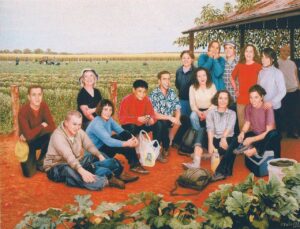
 On October 26, 2002, the renovated structure, renamed the Palace Memorial Building, opened and the opening ceremony was attended by some 250 invited guests, including members of 12 of the families of those who died. Frank Slarke, the father of the dead Australian twins, read a poem he wrote as a eulogy. Since then, over one million visitors have visited the building.
On October 26, 2002, the renovated structure, renamed the Palace Memorial Building, opened and the opening ceremony was attended by some 250 invited guests, including members of 12 of the families of those who died. Frank Slarke, the father of the dead Australian twins, read a poem he wrote as a eulogy. Since then, over one million visitors have visited the building.
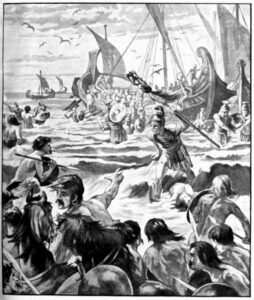
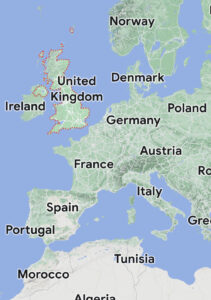 Before Julius Caesar invaded Britain, many Romans didn’t believe it existed. Julius Caesar was the first-ever Roman to invade Britain. He did it twice in the years 55 and 54 BC. Some Romans believed Britain to be just the foot of another huge northern continent. Others thought it was a place full of unbelievable riches, whilst most thought it just didn’t exist.
Before Julius Caesar invaded Britain, many Romans didn’t believe it existed. Julius Caesar was the first-ever Roman to invade Britain. He did it twice in the years 55 and 54 BC. Some Romans believed Britain to be just the foot of another huge northern continent. Others thought it was a place full of unbelievable riches, whilst most thought it just didn’t exist.
In the course of his Gallic Wars, Julius Caesar invaded Britain twice: in 55 and 54 BC. On the first occasion Caesar took with him only two legions and achieved little beyond a landing on the coast of Kent. The second invasion consisted of 628 ships, five legions and 2,000 cavalry. The Roman legion is the largest military unit of the Roman army,  comprised 5,200 infantry and 300 equites (cavalry) in the period of the Roman Republic (509 BC–27 BC) and 5,600 infantry and 200 auxilia in the period of the Roman Empire (27 BC – AD 476). Caesar’s force was so overwhelming that the Britons did not dare contest Caesar’s landing in Kent, waiting instead until he began to move inland. Caesar’s forces eventually made their way into Middlesex and crossed the Thames, forcing the British warlord Cassivellaunus to surrender, after which Caesar set up Mandubracius of the Trinovantes as client king, basically a sub king. As with all conquerors, Caesar included the accounts of both invasions in his Commentarii de Bello Gallico, with the first significant first-hand description of the people, culture, and geography of the island.
comprised 5,200 infantry and 300 equites (cavalry) in the period of the Roman Republic (509 BC–27 BC) and 5,600 infantry and 200 auxilia in the period of the Roman Empire (27 BC – AD 476). Caesar’s force was so overwhelming that the Britons did not dare contest Caesar’s landing in Kent, waiting instead until he began to move inland. Caesar’s forces eventually made their way into Middlesex and crossed the Thames, forcing the British warlord Cassivellaunus to surrender, after which Caesar set up Mandubracius of the Trinovantes as client king, basically a sub king. As with all conquerors, Caesar included the accounts of both invasions in his Commentarii de Bello Gallico, with the first significant first-hand description of the people, culture, and geography of the island. 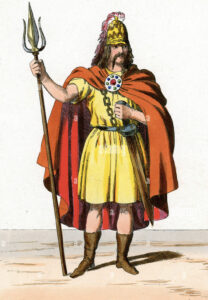
 Caesar’s writings are thought to be the start of the written history or at least the protohistory of Britain.
Caesar’s writings are thought to be the start of the written history or at least the protohistory of Britain.
It seems odd to me to think that people could simply not think that Britain exists, but I suppose that in a huge part of our world’s history, and actually still with some people today, it was thought that the Earth is flat, meaning that the horizon we see is all there is. If that is your mindset, it would be easy to limit the Earth to the horizon we can see, but it would not be an assumption that would be based on fact. Now with satellites and airplanes we know that the Earth is definitely round, just like the Bible and most people have said. And that said, we know that Britain existed long before the men of Caesar’s time found and invaded.

